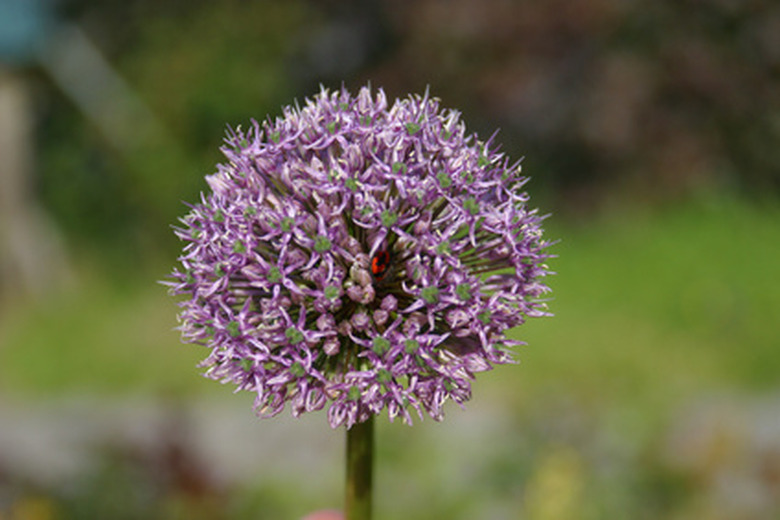Allium Globemaster Propagation
Used widely as a cut flower, the Globemaster is easily grown in most home gardens. However, because the plant is a hybrid, developed by crossing two different species of alliums, flowers are sterile; any chance seeds that may be produced by Globemaster plants in the garden will be unviable. Propagation of the plant is accomplished strictly through separating the bulbs as they naturally divide each year.
About Globemaster
The Globemaster giant allium is the horticultural offspring of selective breeding between Allium christophii, sometimes called the Star of Persia flowering onion, and A. macleanii. Both parent species are hardy, surviving winters in the United States to USDA Zones 4 and 5, and they feature tall flower stalks, or inflorescences, between 2 and 3 feet in height. Globemaster is regarded for its bluish-purple ball of flowers on a single stem, 36 to 40 inches in height, which usually reaches full bloom in midsummer. The inflorescence makes an excellent cut flower, lasting two weeks or more in arrangements. Dried flowers also age well.
- Used widely as a cut flower, the Globemaster is easily grown in most home gardens.
- Globemaster is regarded for its bluish-purple ball of flowers on a single stem, 36 to 40 inches in height, which usually reaches full bloom in midsummer.
Cultural Requirements
As with any perennial, site selection and preparation is key to the long-term success of the plant. As with other flowering onion species, Globemaster alliums prefer rich, well-drained soil in a spot that receives six to eight hours of sun daily. Ensure the planting site is well-drained by incorporating a generous ratio of sand into the native soil mixture at the time of planting.
Though the parent species are hardy to USDA Zones 4 and 5, Allium Globemaster is hardy only to Zone 6, and will also not perform well when grown in zones south of USDA Zone 10, as most species of flowering onions require between 12 to 22 weeks of cold temperatures to flower the following year. Alliums, including Globemaster, are known for their long dormancy, lasting from the end of flowering in summer until the emergence of new growth the following spring.
Bulb Division and Replanting
Though they reproduce naturally by producing offspring shoots, or bulblets, from the parent bulb, bulblets usually do not grow to flowering size until the second year. Bulblets are ready for harvest once the aboveground leaves have withered and faded, which occurs after flowering. To divide Globemaster alliums for propagation, the bulblets, along with the parent bulb, should be lifted from the ground, and then the bulblets gently detached and immediately replanted. Bulbs should be planted 4 to 6 inches deep, tip side facing upwards, and spaced 6 inches apart.
- As with any perennial, site selection and preparation is key to the long-term success of the plant.
- To divide Globemaster alliums for propagation, the bulblets, along with the parent bulb, should be lifted from the ground, and then the bulblets gently detached and immediately replanted.
Fertilizing
At the time of initial planting, Globemaster benefits from the incorporation of well-rotted manure or compost in the planting matter, along with a top-dress application of 8-8-8 or other balanced fertilizer. After plants have become established, they may be fertilized with an application of any balanced fertilizer as soon as growth is evident in the spring.
Watering
The parent species of Globemaster, along with many other types of flowering onions, are indigenous to dry climates, and their origins provide a clue about how to irrigate these flowering giants. Generally speaking, bulbs do not need to be watered while they are dormant; the combination of too much water, lowered evaporation due to cooler temperatures and poorly drained soil may lead to bulb rot and the death of the plant. After foliage has emerged, plants should be watered lightly at regular intervals through the end of flowering.
